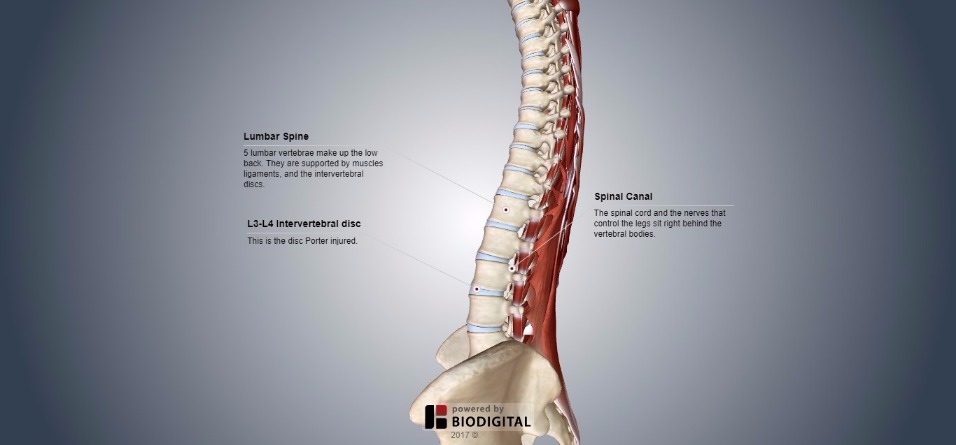Porter’s back injury specifically is a herniated disc, between the L3 and L4 vertebrae in the low back. A disc is a ring of cartilage that provides cushion and shock absorption between the bones of the spine, and in this type of injury, the disc is compressed between two vertebrae, causing part of that disc to leak out from between the two bones.

A disc herniation becomes problematic when the cartilage disc herniates into the spinal canal, sitting right behind the lumbar spine. The disc begins compressing on the spinal cord or the nerves that come directly off the cord, resulting in significant pain and in some cases loss of function. A telltale sign of a disc herniation is unexplained radiating pain from the back into the leg, and that appears to be what Porter suffered from.
Surgery for the injury involves removing the small piece of the disc that has herniated into the spinal cord. After that, the pain goes away, and return to full function is expected if the tear was not that large. In Porter’s case, they’re calling it a “microdiscectomy,” which is the simplest type of surgery for this injury and
has the best long-term prognosis. That’s promising.
The problem is not with whether Porter will recover, though. It’s the potential for reinjury, which is high given the stresses that competing in the NBA puts on your back. Players with disc issues are more likely to suffer recurrent injury to the area, and are at a high likelihood for arthritis and chronic back spasms late in their careers. The low back absorbs much of the force the body takes during running and jumping, and these injuries can result from issues with the player’s biomechanics, and things such as muscle imbalances that aren’t corrected are more likely indicators for future reinjury. Missouri’s medical staff is going to have to work closely with Porter to correct any underlying issues that may have caused the injury.
A couple of things are working in Porter’s favor, that could make his back injury less severe than the ones suffered by Motiejunas and Sullinger. As previously mentioned, Porter’s herniation doesn’t appear to be that severe and it is unlikely that a large portion of the disc is being removed, which preserves a majority of the cartilage in the area. The second is that this is an L3-L4 disc herniation. Herniations most commonly occur at the L5-S1 level — the lowest intervertebral disc that absorbs the most stress from supporting the rest of the column. This level is also the one that is most likely to see repeat injury. That Porter’s is higher up the spinal column is a small victory. It’s like if you took out a retaining wall on the bottom floor of a five-story building, versus on the third floor — the damage to the third story wall is still problematic, but you don’t have to worry about the entire building collapsing, like if the problem was on the bottom floor that supports the rest.
What does back surgery mean for Michael Porter Jr.?


 + he's 19
+ he's 19